As I have mentioned on other pages of this website, in the summer of 2023 I moved cross-country and in the process had to let go of most of my equipment. If you are looking for something that Google says is supposed to be here but you can't find it—that's probably why.
I read a message somewhere from a guy who collected test equipment. I was both envious and frightened; envious that he was doing it because I could easily see myself doing it too, and frightened because I could easily see myself doing it too.
Notes: Tube testers have their own page
VOMs, VTVMs and other multi-meters have their own page
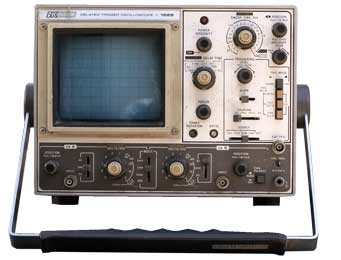 B&K Precision 1525 Oscilloscope
B&K Precision 1525 Oscilloscope
The Old Man was an electronics tech at work; at home he dabbled with projects but most didn't require a scope. When I was growing up he had an old Dumont that I thought was great, but it was also very limited. That was given away, and eventually replaced with three or four B&K's a friend gave him. Those slowly disappeared until he was left with this one, which was given to me when I took the intro-to-electronics class. It was "take it and don't bring it back!" It freed up space on his bench for more useful things for what he did, and he could still borrow it back from me if he needed it.
It's a nice scope. By modern standards I'd call it middle-tier. It's analog and everything new is digital. At school we used a Tektronix which was very, very similar but a bit newer, and I don't think it had any additional features that I needed.
Every so often I come across one of those big, impressive looking modular Tektronics rigs and I imagine where it would go on my bench. But so far I have yet to need a scope and not have the B&K do what was needed, so there's no real reason to replace or suppliment it.
Current Conditon: works fine.
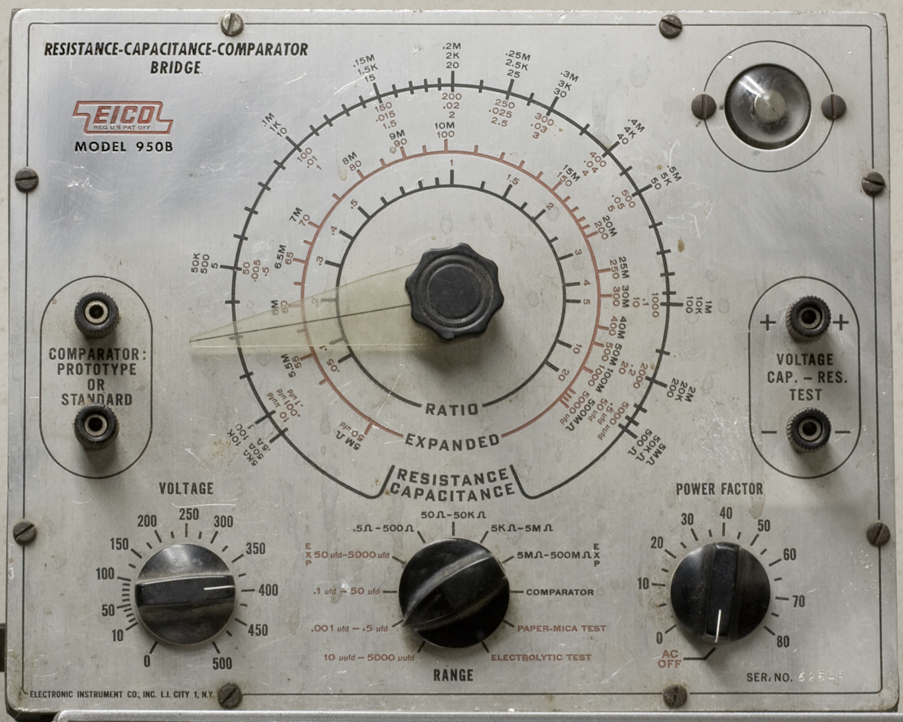 EICO 950B Resistance-Capacitance-Comparator Bridge
EICO 950B Resistance-Capacitance-Comparator Bridge
Sounds impressive doesn't it? This is another magic-eye machine. Thankfully mine still works. This was another one from the great radio-test-equipment purge from The Old Man's bench.
These are relatively common, I've seen them for sale on eBay and elsewhere.
Phil's Old Radios has a nice page about this. Boat Anchor Pix has a fleet of them.
Another item with a weak eye tube (moron this below). This one takes a 1629. They're supposedly less expensive than 6E5s and 6U5s, but not as much as they used to be.
This one works backward (to my mind). You hook up a capacitor and then turn the dial until the eye tube iris is at its widest, and that's your reading. Usually eye tubes are set so you close them until the leaves just touch, and that's your optimum.
I've only used it a little bit. It tests electrolytics, and I've got a big 2-stage can in a chassis that I don't want to replace if I don't have to, so I'm going to try and test it in place (I'll disconnect the ground to take it out of the circuit). If it saves me having to pull that can, it'll be worth the price of a new eye tube right there.
SO, here's one that gets booked to "tuition." I mentioned earlier that the magic eye was weak. I had to turn off the overhead lights to see it. So I added it to my shopping list and ordered a replacement. Actually I ordered two because I like to have a backup in inventory in case I need one again.
After I ordered the tube, I was messing with machine again and noticed I was getting shocked on the cabinet. And not just a little, I was getting a pretty good zap; the bypass capacitor on the power transformer's primary side was leaky as hell. So I cleaned the face up a bit with naval jelly and put it back together. Looks nice, works nice. (Until I actually did a test, when I got shocked again. If I'd bothered to look harder at the schematic, I'd have found that big .25 @ 600V job that also bypasses to chassis ground. But back to the story...)
Now the eye glows beautifully. It wasn't weak, the damned leaky bypass cap was shunting power and lowering the operating voltage.
So now I have two 1629s on the way. I need none, but wouldn't mind one to put in the tube caddy; but two? For awhile I was thinking I could use a 1629 to replace an "expensive" 6E5/6U5, but the prices really aren't much different anymore.
Anyway, the moral is if you have a weak eye tube, test it on a tube checker (or something else that uses them) because it may be fine.
This guy is on Teardown Tuesday to show the complicated inner workings.
Current Conditon: works fine.
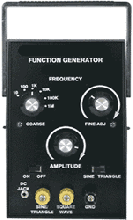 Elenco FG-500k Function Generator kit
Elenco FG-500k Function Generator kit
Another electronics class acquisition—I wanted to be able to do some of the labs at home. Plus I enjoy building kits. Elenco has a few, and this function generator looked both interesting and useful. I was very happy with it; it's fairly easy to build (I was able to do it), the instructions were clear, and ultimately I had something I could use for experiments.
I checked its output on the scope and the wave forms (it puts out sine, triangle and square) all looked great; the square is rounded off at the top speed (1 Mhz) but still perfectly good for what I was doing. Also gave me some practice for my marginal soldering skills. The only bad part is that its output isn't strong enough to align radios.
Current Conditon: works fine.
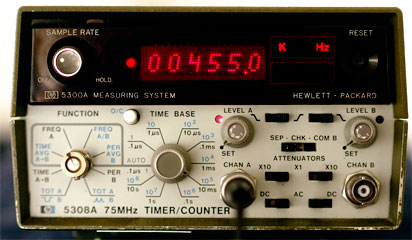 Hewlett-Packard 5308A Frequency Counter
Hewlett-Packard 5308A Frequency Counter
Purchased because it was cheap ($30) and my Heath freak counter (no longer on this page) never panned out.
This one works, though like most things I seem to get, it is not quite right. The HP system here is actually two halves married together: the upper half (display) is a 5300A Measuring System, and the lower half is the 5308A freq counter. So after scouring the net, I finally found some documentation on this thing, and the first thing I read is the 5308A only works with the 5300B measuring system.
Oh, joy. So that's why it was cheap. Stung by fleaBay again. But it arrived and I fired it up anyway, hoping the previous owner had actually used it with the 5300A top, and it wasn't just slapped together to sell.
It does work: the 5300A has a six-place readout, and the 5300B has eight places. In various modes the left-most digits get truncated on this thing. So the trick is that instead of using the auto-ranging feature, you set the time base manually and you can keep it within the 6-digit range. At least I've been able to do that so far.
In case anyone cares about the specs, it's 75MHz. Two inputs and you can do ratios and comparisons between the two. It's a counter and a timer, so you can do a variety of things with it that I know nothing about.
Funny—if it didn't say HP on it, I'd swear it was a mate to my B&K scope. They definitely have the same look and feel.
So I mentioned above that this thing died on me and I bought another machine to replace it. I don't know what happened other than I turned it on and got 9999999 and nothing could clear it. Months later, when I was testing the other meter, I thought I'd plug this in again and see what it did; and it works fine. Or at least it does at the moment. Maybe it doesn't like the idea of going back on eBay again.
Current Conditon: works when it feels like it.
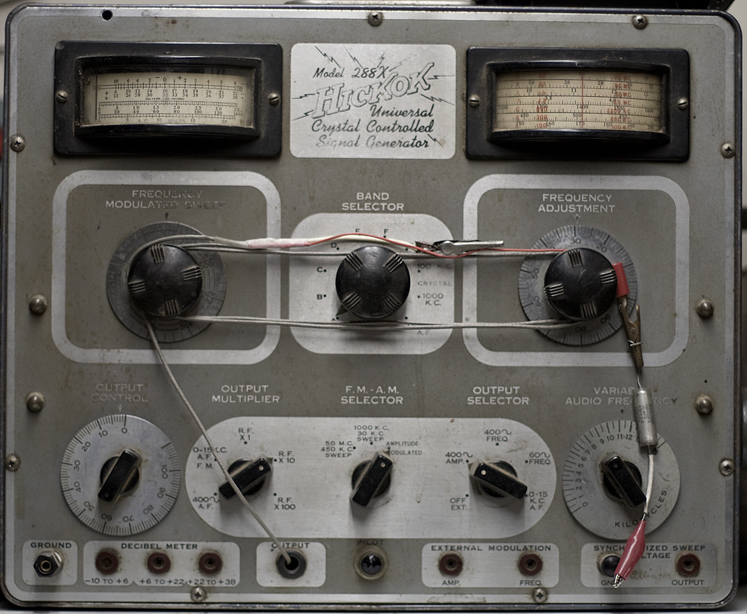 Hickok Model 288X Signal Generator
Hickok Model 288X Signal Generator
The companion to the 156 Trace-o-Meter above. A shame the tracer doesn't work because they'd look great together on my bench.
This was The Old Man's signal generator. I got it when he purged his workbench of the last of his radio test gear, because I'm the only one using it anyway and it frees up space for more useful things. But this carried a lot of sentimental attachment. He bought it new and used it when he was a professional tech. And it's been on his bench wherever we lived for as long as I can remember.
This came out in 1946. The X means it's crystal controlled. The model 277 is similar but lacks the audio meter on the left. Hickok's owner's manual covered all three so there isn't too much difference between them.
It's impressive, I'll give it that. It makes my RCA (below) look like a toy. I just got it and haven't had a chance to get it yet; an influx of new stuff means I have to reorganize and remodel the shelves above my bench in order to fit everything in, and that will take some time.
Crawls Backward (when Alarmed) has a write-up on this. Steve Johnson offers a free download of the manual; and as usual there's more if you want to search the net.
Current Conditon: works.
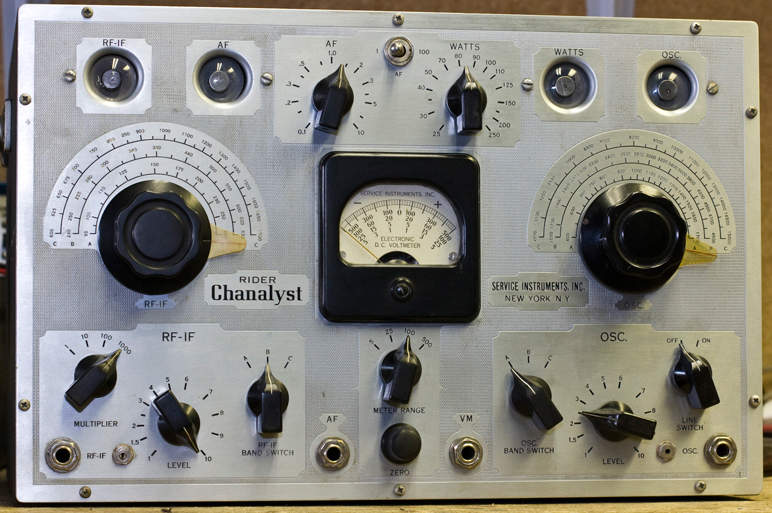 Rider Chanalyst Model 11
Rider Chanalyst Model 11
I really bought this because I'm a sucker for magic eye tubes, and this one has four. Four! If all of them go out, you'll go broke replacing them.
But I also wanted another shot at a signal tracer, because my Hickok (above) is dead and I haven't been able to fix it.
There's a fair amount of information about this sprinkled across the internet. Phil's Old Radios has a nice write-up on it, including how to make it play as a TRF radio; Boatanchor Pix has three of them; and Steve Johnson has some documentation for free; there's more if you want to Google around for it.
There's also a two-part article that ran in the October and November 1938 issues of Radio Craft magazine, written by Rider, talking about how it works and how it is meant to be used. I transcribed the article as a webpage here.
John F. Rider was a writer/publisher of radio servicing books; his heyday was the 1930s and 40s. His most famous work was the Rider Perpetual Troubleshooter's Manual, which was an annual collection of service literature that he could reasonably collect together. For people who work on old radios, Riders PTMs are still useful today; the major makers' (RCA, Philco, Zenith, etc.) literature may be available elsewhere, but for the smaller fry, it's Rider or nothing.
But Rider was also an early and big proponent of servicing by signal-tracing, whereby you go can test each stage of the radio and see whether the signal is present and, if so, if it's weak or strong. That rapidly localizes the problem.
I don't know how widely these were used; from what I've seen and heard, not that much. Most professionals knew that most of the problems they encountered fell into recognizable, similar categories, and they could quickly figure out what the problem was and knew by experience what to do to fix it; and few of them wanted to lug yet another big piece of equipment into a customer's home if he didn't absolutely have to. So I think the signal-tracers were more likely used for learning, which is what I wanted to do. If I learn how to use a signal tracer, it'll help me in my understanding of radio overall.
Mine arrived and of course, it's DOA. Photos and discussion in Teardown Tuesday.
Current Conditon: works
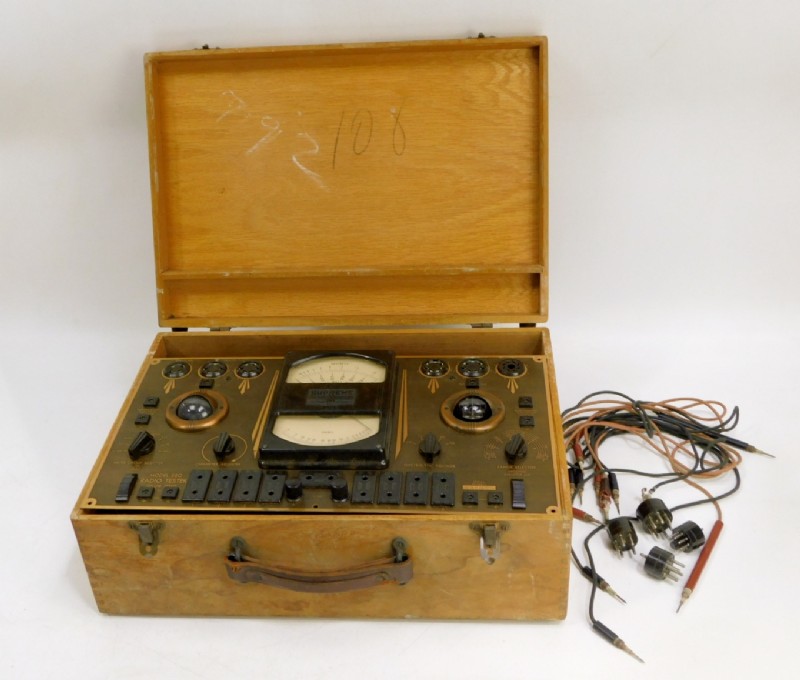 Supreme Model 550 Radio Set Tester
Supreme Model 550 Radio Set Tester
I always get Superior and Supreme confused. Superior was an inexpensive brand that sold mail order and on time installments in advertising in the back pages of many magazines. Supreme was, according to Alan Douglas, a quality brand from Greenwood, Mississippi.
This is a set tester—a swiss-army knife of tools in a single box. It combines a tube tester, a volt-ohm-milliammeter (AC and DC), and can measure and test capacitors, both eletrolytics and electrostatics, for leakage. Not bad for 1936. The idea was that a field tech would enter the home with this and a toolbox/tube-caddy and be able to do almost anything to a typical set.
.jpg) I bought this from an online auction for about what it cost brand new. I was mistaken in that I thought it had two magic eyes; it actually has none. One is a neon lamp used to capacitor leak tests, and the other is the 71A tube that acts as a high-voltage rectifier.
I bought this from an online auction for about what it cost brand new. I was mistaken in that I thought it had two magic eyes; it actually has none. One is a neon lamp used to capacitor leak tests, and the other is the 71A tube that acts as a high-voltage rectifier.
 The manual for it is available. Link goes to Steve Johnson.
The manual for it is available. Link goes to Steve Johnson.
Current Conditon: in transit. Needs evaluation.
